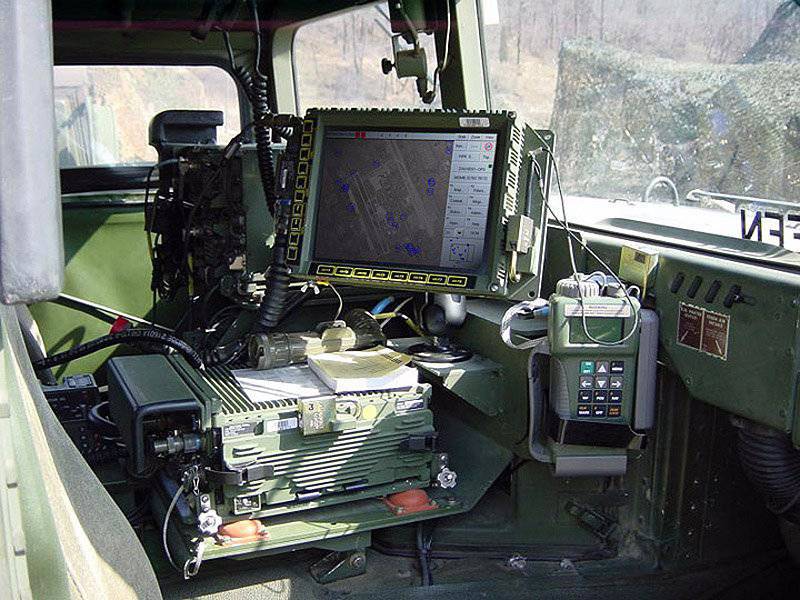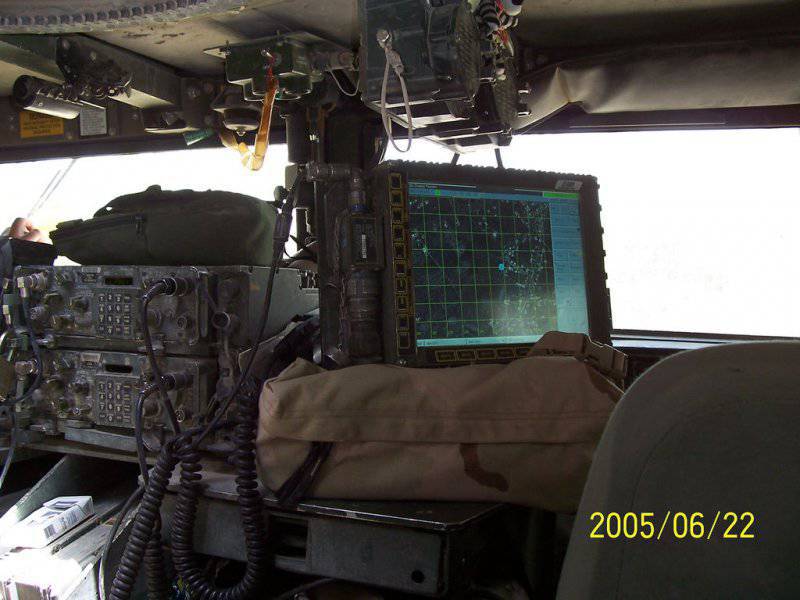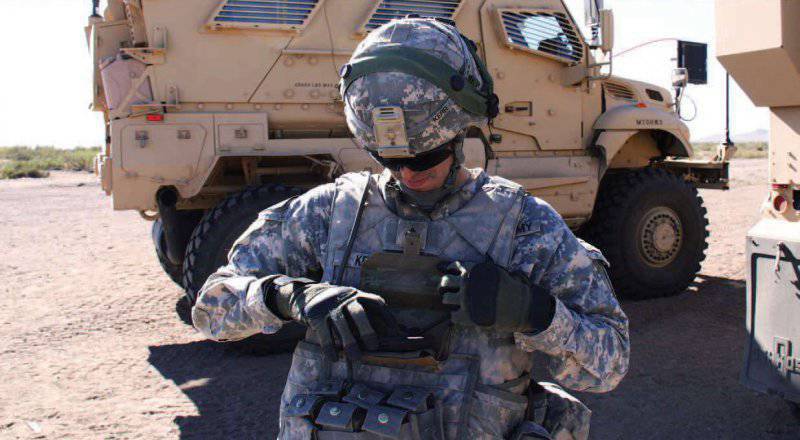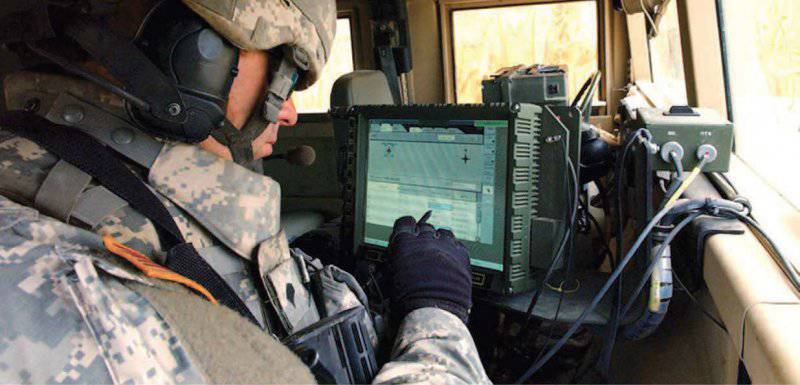Combat control system of the XXI century FBCB2
The FBCB2 system is installed in the STRYKER machine for working with “friend or foe” applications.
The brigade-level combat control system of the 21st century and below (FBCB2) is today the most proven combat control system from an operational point of view, ranging from peacekeeping operations and the deployment of a coalition in Kosovo and Bosnia, the usual mechanized maneuvering war in Operation Iraqi Freedom, peacekeeping operation " Permanent Freedom, led by special operations forces, and ending with subsequent battles against urban and rural rebels in Afghanistan, Iraq, Libya, and other hot spots in the world.
FBCB2 works by distributing various situational information on the battlefield, graphically presents the soldier with data in various GIS geographic information system formats, and also supports a number of cartographic systems, including VPF (Vector Information Format), CADRG (Compressed ARC Digitized Raster Graphics - compressed format digital raster graphics), DTED (digital data on elevations on the ground), NITF (national visual information transfer format), and even ASRP (Aiborne SIGINT (signal intelligence)) and and collection of information) from the British Cartographic Service. The system is designed to receive information generated from on-board "combat" sensors, such as driver viewing devices, laser range finders and indicators and kits weapons mass destruction (CBRN), but also from on-board indicators that allow effective and long-term monitoring of the presence of fuel and ammunition, as well as engine diagnostics sensors. For operation, the FBCB2 combat system is also equipped with training systems for laser target destruction, for example, MILES.
Northrop Grumman has overall responsibility for the design and development of FBCB2 with computing equipment supplied almost exclusively by DRS Tactical Systems; The work is being carried out on the L-Band (300 – 1550 MHz) communication channel supplied by ViaSat; also, the upgraded ground-based EPLRS core network (Enhanced Position Location Reporting System) has been upgraded from Raytheon.
You can not stand still
If you study the lessons of the initial deployment of FBCB2 in the middle of the 90-s to the present, then the USA is in the middle of a major evolutionary change involving a new version of the software, called the FBCB2 joint release (FBCB2) and its further improvement.
The vision for the FBCB2 program over the next five years is to transform the capabilities of the FBCB2, focused on the army, to general military command - platform (JBC-P) while continuing to provide full support for modern combat requirements. The two main areas of focus for this program are the improvement of general military interaction through JCR, and the implementation of network upgrades to the L-band channel (high frequency range).
The experience gained in operations in Iraq consisted in the need to combine situational awareness of ground forces and marines into a single common operational picture, as it turned out that the two situational awareness systems of these combat arms were incompatible. Currently, there are several forums that direct the rapprochement of situational awareness and command control of the army and marines. In addition to universal supervision from the Joint Compliance Control Board (JROC) and the Army and Marine Corps Council (AMCB), joint initial testing to merge situational awareness and command and control between the army and marines, which was organized and regularly facilitates the implementation of technical solutions and commissioning. There are two main areas: battalion control points and above (BaA) and network; and airborne and ground brigade-level vehicles (BaB) and dismounted systems of soldiers and infantrymen and networks. The latter is part of the operational control convergence with program control FBCB2. For the brigade and below, the FBCB2 system was identified as a tactical command and control system for bringing the marines and army closer together based on the lessons learned from Iraq and Afghanistan and the JROC Memorandums 161-03 and 163-04.
As a result of these lessons, the shareholders of JROCM, the army, the marines, and others have joined forces to develop requirements for a single tactical operational management capability called JBC-P (Joint Battle Command-Platform). After the expanded work of the integrated headquarters, the JBC-P Opportunity Enhancement Document was approved by the JROC Council in May 2008. This CDD is the 2 Extension (Increment 2) for the document that sets the operational requirements for the FBCB2 system and captures the general management and situational awareness capabilities required for rotary-winged vehicles, ground vehicles, dismounted soldiers and marines. For BaB, the initial merge was carried out in 2011-2012 with the new FBCB2 software as part of the joint capabilities of the FBCB2 JCR. The complete merger of BaB was carried out in 2013 year with the realization of JBC-P CDD features. FBCB2 JCR passed a series of tests and assessments aimed at reducing risk and ensuring backward compatibility, which led to limited customer testing (LUT). After these tests, it was decided to deploy the system. After successful extended tests, the army and the marines deployed JCR capabilities in 2012 to identify units in accordance with the requirements of the army and marines.
There are eight clear JCR improvements over the currently deployed FBCB2 system with the 6.5 software version - five in the near future and another three in the medium term. The release of JCR features is the following:
- A new software architecture with a modular layout, called the battle command product line BCPL (Battle Command Product Line), which provides unique products for marine corps users and army users involved in logistics;
- Dynamic and flexible database development using self-descriptive situational awareness (SDSA);
- Simplified army ground communications system EPLRS using tactical gateways of tactical services TSG (Tactical Services Gateways) at the command posts of combat brigades and battalions;
- Enhanced satellite network security with built-in KGV-72 encryption device that allows the exchange of secret information;
- A new cartographic engine, called the Common Arms Tool Kit (CJMTK), which allows the use of more modern commercial imaging products.
There are also three more important opportunities coming up with future JCR options that will be available in the near future:
- Sensor integration from a program developed as part of the former FCS program (now BCT Modernization);
- Installation of TIGR (Tactical Ground Reporting) messaging system developed by the DARPA into the onboard computer FBCB2. This installed software (software) has been recognized as extremely popular when performing operations in Iraq and Afghanistan;
- L-band transceiver (390 – 1550 MHz) self-tracking (BFT) and network architecture, which is planned to improve the throughput of 10 times in comparison with the current capabilities of the transceiver.
As a follow-up to the JCR, the FBCB2 JBC-P (Joint Battle Command - Platform - the command platform of the combined armed forces) is also planned. The combat developers of the army and the marines worked together on writing the concept of JBC-P which included the experience gained in Iraq and Afghanistan. Its goal is to strengthen the convergence of the army and marines, as defined by the JROCM. The program office is currently in the process of selecting and developing acquisition and transition plans from FBCB2 to JBC-P.
Where possible, JBC-P will use the existing hardware, software and communication architecture of the FBCB2 system based on previous investments without disrupting collaborative interaction. A new strategy for developing this program includes a two-year transition period between FBCB2 and JBC-P. Funding and development of JBC-P began in the 2010 year, and the program for configuring the FBCB2 system was scheduled to begin in 2012 in the year, but it is still being finalized and debugged.
The list of the army somehow affected several programs related to the program Combat Systems of the Future (FCS) and its cancellation. However, the development of the FBCB2 system had little impact. Although part of the FCS program for the habitable vehicle was closed, the developed technologies were transferred to 73 army combat brigades. FBCB2-JCR is the main player in the first phase and the army has successfully integrated the FCS network integration kit with the FBCB2 system on machines in Fort Bliss. The army assumes that much will be learned from these tests, and this will help inform army commanders about the best approach for combining these promising and current capabilities of the military network and combat command within the Unified Battle Command. In the procurement and material supply led by the Assistant Minister of the Ground Forces, the initial tests of the super combat system of the joint command are currently evaluating the best integration approaches and capabilities of the current military network and military command in the army regarding a concept called the modernization of the BCT brigade combat teams. PM-FBCB2 involves the continued use of the Combat Command (BCPL) product line in future versions of JBC-P software as part of UBC.
Automated workstations of the FBCB2 system in the headquarters vehicle
Information processing issues
As for any incremental or incremental improvements or upgrades, questions inevitably arise. The existing deployed FBCB2 computer systems are the original version of V4, followed by eV4. There are approximately 7000 V4 and 32000 eV4 systems in operation and installed on various platforms in the army and marines. Software management strategy is to continuously upgrade equipment, when it is economically feasible, to take advantage of operating parameters, ready-made software solutions and implement it in an additional computer system as part of FBCB2. In addition, computer equipment should never be a deterrent when it depends on the implementation of tactful operational control of FBCB2 / BFT.
The program’s intention is to replace all obsolete V4 computers with the JV5 variant in the army, since the information processing speed of the V4 no longer corresponds to the JCR software. Only the V4 processor unit and hard drives will be replaced, the display and keyboard are compatible and cannot be replaced until they break.
The next-generation computer architecture goals for FBCB2 are pursued through the Technology Implementation Plan, which is part of the DRS contract; The plan is updated every six months. The most recent examples of this strategy have been the development of a JV5 processor unit and a DB20 hard drive. The JV5 processor unit processes data three times faster, and a 160 GB hard drive will replace the current 40 GB. The hard drive bay has been moved to the JV5 PU processor unit for future expansion. Future upgrades will eliminate the need for an external DAGR (GPS receiver) or PLGR (lightweight GPS receiver) as well as appropriate software installation kits, thereby freeing up valuable dimensions, weight and power consumption. The JV5 was also created to meet the needs of the Marine Corps in the version that has a built-in TacLink card, necessary for the architecture of its subnet SINCGARS (Single channel ground and airborn radio system - a single system of single-channel radio communications of ground forces and aviation) This strategy will continue with the development of computer hardware for the JBC-P.
The equipment is improved in other ways, for example, through the built-in device for correcting errors and countering SAASM GPS interference in order to reduce the required number of DAGRs and to promote the army’s goals of reducing the size, mass, power consumption and cost. Qualification tests of the system were successfully conducted. Production began with SAASM built into 2011. Other innovations for the JV5 include built-in communication devices, although no clear deadlines have been set for them. In the army, they are going to use an encoder that is external in the control loop rather than a built-in JV5 to meet the Type 1 safety requirements for a friend or foe identification system. JBC-P requirements include a smaller device, called Dismountable (removable), which is designed to create a reverse communication channel through the platform.
The workplace of the operator FBCB2 "friend or foe" in the armored car HMMWV
Interaction and combat identification
Any command and control system and FBCB2 is no exception, it should work with other systems in order to maximize its advantage. The key zone of combat control systems is support and integration with combat identification in order to support additional, deductive approaches in order to reduce casualties from friendly fire. The CID (combat identification) Council of the Army and Marine Corps, conducted in 2004, identified and assessed the gap in capabilities and set the priorities for investment strategy recommendations. The ground-to-air and ground-to-air CID studies recognized the importance of situational awareness for CID. Many of the ground-to-ground CID studies for AMCB are provided, implemented, and are on the way to reducing the risk associated with combat identification, while reducing fratricide and increasing combat effectiveness.
As part of this research, three indicators of situational awareness with Combat ID were developed with the intention of reducing current inequality of opportunity. They consisted of the accuracy / waiting time for the exchange of messages about the location of their forces, the density of the FBCB2 / JBC-P system in the ground forces and the joint interoperability defined as the ability to exchange information about the situation between the combined arms platforms. These new indicators have been included in the JBC-P CDD and will improve the accuracy of the positioning of their forces and the deployment density requirements of the FBCB2 / JBC-P system, in addition to what is currently needed for the Combat Command.
Also, within the framework of FBCB2, work is underway to integrate situational awareness based on RBSA radio devices (Radio-Based Situational Awareness) into the FBCB2 network. RBSA is an opportunity that uses the existing ITIP ASIP SINCGARS (more than 400000 in service in the army) to distribute the location of friendly troops through the SINCGARS waveform using Combat ID. The location information will then be displayed on the FBCB2 / JBC-P live image display and will provide unprecedented situational awareness of allied forces on the battlefield. RBSA supports JBC-P beacon requirements for platforms that do not require the full or partial capabilities of JBC-P C2 / SA.
There is also a requirement for obtaining interoperability between FBCB2 and non-US systems, NATO and others. The leadership of the FBCB2 program is collaborating with the Peterson Air Force Operations Center to facilitate communication between US forces using FBCB2-BFT and the command of the International Security Forces in Afghanistan (ISAF), which use its own force identification system. The so-called initial opportunity “only situational awareness” was provided to troops in May 2007 based on the FBCB2 6.4 software. All these seven years, intensive work has been carried out to obtain the full interaction of operational management and situational awareness.
Networks
The FBCB2 BFT core network strategy recognizes that SATCOM satellite communications and each landline link have their own advantages and disadvantages, and when asked questions relating to this direction, what forms all this should take in the future in the future, the Program Office always asks the question " do we use these advantages for the benefit of the soldiers? ”PM FBCB2 currently believes that the inherent strength of the ground network is currently in network bandwidth, which provides the user with more complete and timely hydrochloric situational awareness, while limiting clear line of sight to all and well understood. The software office is currently taking steps to improve the EPLRS network architecture with TSG tactical services distributed gateways, which includes inbound and outbound connectivity in order to minimize isolated and disabled subnets.
SATCOM’s strength lies in over-the-horizon service, which is highly desirable during distributed operations in mountainous terrain. However, there are difficult tasks of integrating the SATCOM architecture with the terrestrial network at all levels of command due to problems with complexity and security. It is well known that BFT (with the L-Band SATCOM transceiver) has a higher information delay compared to the ground-based FBCB2 system. It should be noted that when considering SATCOM, army identification works with some limitations, such as the previously mentioned integrated encryption device KGV-72 and transceiver BFT2.
In support of improved over-the-horizon (out of line of sight) capabilities, ViaSat, contracted by Northrop Grumman, has developed new prototypes of L-band satellite communications designed to provide higher speeds with more messages per minute and reduced latency and increased accuracy. This was first shown to the army in June 2008 of the year by ten examples, which were then delivered in June – September of the 2010 of the year and used for testing and evaluation. The solution is based on the company's so-called “Arclight” solution, which uses the DVBS2 variant to install a smaller antenna, which could otherwise be VSAT-based terminals.
Since the FBCB2 system was deployed, Raytheon's EPLRS radio has provided its situational awareness backbone network. The architecture for FBCB2 was developed in the 90's. The EPLRS technology then limited the bandwidth range, but FBCB2 did not experience any significant changes until the JCR capabilities appeared. After this opportunity, EPLRS has evolved an order of magnitude. ELPRS today is a fourth-generation version of radio stations and does a lot more than just providing information access to FBCB2. The EPLRS data transfer rate has now increased 18 times compared to 90s and now has a standard Ethernet interface, allowing connection to web-based applications: chat (real-time information exchange), video and electronic services. mail above and below the FBCB2 system, but which can also be provided in parallel to serve the needs of the FBCB2 applications.
Due to the fact that it was based on an older 90-s architecture, the amount of time spent on configuration and networking of the EPLRS is very long and must be rescheduled. JCR and JBC-P will cover a fully specialized IP networking and networking market with radio stations becoming very similar to routers. When downloading an IP address and proper encryption, it allows the user to enter the network automatically, without rebuilding the network itself. To support this, Raytheon has developed a network management software for EPLRS for JCR. The effect of the new technology is to simplify the process. The network building time for the original EPLRS generation can take a week, now has decreased to almost 4 hours in order to further reduce to exactly two hours.
Internal EPLRS programs are configurable software that allows you to improve and receive new features as part of a regular planned software replacement, which happens for about one to three years. A promising component for EPLRS is the ability of DARPA to access the dynamic spectrum created to improve frequency efficiency through reuse, the component is scheduled to be delivered to troops in the 2010 year.
PM-FBCB2 integrates promising programmable radio stations that will completely replace other types of radio stations in the army. It is assumed that they will include a family of radio stations JTRS (reprogrammable radio stations using a single communication architecture) and possibly other radio systems that the army will decide to purchase.
As for the future, the Software Office is working at the engineering level with the WIN-T Network Development Department. This work includes the ability to use the soldier information network extension for WIN-T as feedback to the upper echelons in order to take advantage of the increased bandwidth to support new applications running on FBCB2 computers, such as chat, Open Office and the TiGR system (Tactical Ground Reporting - tactical information exchange system).
TiGR is the main pilot project of the Advanced Defense Research DARPA project, reflecting the growth of FBCB2. This is a geospatial information system that can impose detailed tactical data on a digital map, such as locations of directional land mines and suspicious rebel shelters. This makes it possible to distribute information in the network, it becomes available to soldiers from other units or even within units in order to preserve the "hard to get" information. In 2011, software was developed for TIGR and FBCB2, operating separately on FBCB2 hardware. After that, the integration of these systems began, which has not yet been completed, but which the army command hopes to complete in the near future.
Materials used:
Weapon Systems Handbook 2013
www.monch.com
www.northropgrumman.com
www.drs-ts.com
www.darpa.mil




Information